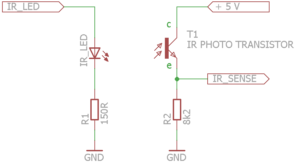A photo-transistors is a bipolar semiconductor device that converts light energy into electric current.
Photo-transistors can be used in any electronic device that senses light. For example, photo-transistors are often used in smoke detectors, infrared receivers, and DVD players. Photo-transistors can be sensible for infrared (IR), visible, or ultraviolet (UV) light although many applications use IR light.
Because photo-transistors, like any transistor, amplify the signal, they produce a higher current than photo-diodes. Photo-transistors are quite fast and their output is practically instantaneous. They are relatively inexpensive, simple, and so small that several of them can fit onto a single integrated computer chip.
Packages that incorporate an IR LED and an IR photo-transistor are also available. They can be used as proximity sensor.
Be aware: most photo transistors have two terminals only, not three as you might expect for a transistor. Do not confuse them with photo diodes.
How a Photo-transistor Works
A photo-transistor is a bipolar device that is completely made of silicon or another semi-conductive material and is dependent on light energy. Photo-transistors are generally packaged in an opaque or clear container that helps focus light as it travels through it and allow the light to reach the photo-transistor’s sensitive parts. A photo-transistor generally has an exposed base that amplifies the light that it comes in contact with. This causes a relatively high collector current to pass through the photo-transistor, which can be converted in a voltage difference with the help of a suitable resistor.

Most important specifications
Maximum ratings.
- Vce,max: the maximum collector-emitter voltage (V).
- Ic,max: the maximum collector current (mA).
Optical-electrical.
- Ic,0: Collector dark current (mA).
- Ic,L: The collector light current (mA), usually specified for a given light intensity.
- Vce(sat): collector-emitter saturation Voltage (V). Only relevant when you use the transistor as a switch. So only on/off states.
- Spectral response: the output of a photo-transistor as function of the wavelength of incident light, usually a range and a peak response (nm).
- IR light ranges from 700 nm to 1000 nm. If you combine an IR LED with a IR Photo-transistor, be sure they match.
- Sensitivity: the output of a photo-transistor as function of light intensity.
- In the schematic diagram above, a higher value for R2 will result in a higher output voltage. But also in lower response rates. Typical student projects work well with values in the range of 1k till 100k.